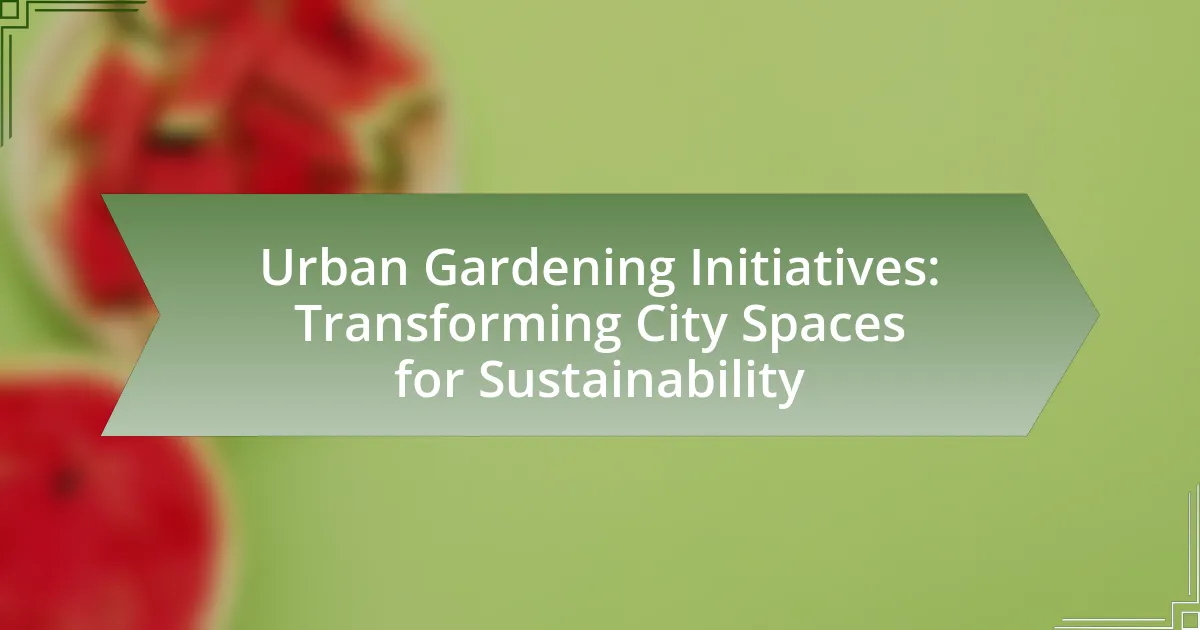The article focuses on encouraging sustainable practices among local producers, highlighting methods such as organic farming, crop rotation, integrated pest management, and water conservation techniques. It outlines the economic benefits of these practices, including reduced operational costs and increased market competitiveness, while also emphasizing their role in enhancing community relationships and environmental health. Additionally, the article addresses the challenges local producers face in adopting sustainable methods, such as financial constraints and lack of resources, and suggests strategies for overcoming these barriers through education, training, and supportive policies. It concludes by dispelling common misconceptions about sustainability and providing practical tips for implementation.

What are Sustainable Practices for Local Producers?
Sustainable practices for local producers include organic farming, crop rotation, integrated pest management, and water conservation techniques. Organic farming minimizes chemical inputs, promoting soil health and biodiversity, while crop rotation enhances soil fertility and reduces pest buildup. Integrated pest management employs biological controls and minimal chemical use to manage pests sustainably. Water conservation techniques, such as drip irrigation and rainwater harvesting, optimize water use and reduce waste. These practices not only support environmental health but also improve the economic viability of local producers by enhancing product quality and marketability.
How do sustainable practices benefit local producers?
Sustainable practices benefit local producers by enhancing their economic viability and market competitiveness. By adopting sustainable methods, local producers can reduce costs associated with inputs like water and fertilizers, leading to increased profit margins. For instance, a study by the USDA found that organic farming can yield higher prices for produce, with organic vegetables selling for 30% more than conventional ones. Additionally, sustainable practices often lead to improved soil health and biodiversity, which can result in higher crop yields over time. This not only supports the local economy but also fosters community resilience and environmental stewardship.
What economic advantages do sustainable practices provide?
Sustainable practices provide significant economic advantages by reducing operational costs and enhancing market competitiveness. For instance, businesses that implement energy-efficient technologies can lower their energy bills by up to 30%, as reported by the U.S. Department of Energy. Additionally, sustainable practices often lead to improved resource management, which can decrease waste disposal costs and increase profitability. A study by the World Economic Forum found that companies adopting sustainable practices can experience a 20% increase in revenue due to heightened consumer demand for environmentally friendly products. These economic benefits demonstrate that sustainable practices not only contribute to environmental health but also drive financial performance.
How do sustainable practices enhance community relationships?
Sustainable practices enhance community relationships by fostering collaboration and trust among community members. When local producers adopt sustainable methods, they often engage with their neighbors, share resources, and create networks that strengthen social ties. For instance, community-supported agriculture (CSA) programs encourage direct relationships between farmers and consumers, leading to increased transparency and mutual support. Research indicates that communities with strong sustainable practices report higher levels of social cohesion and collective efficacy, as seen in studies conducted by the American Journal of Community Psychology, which highlight the positive correlation between sustainability initiatives and community engagement.
Why is it important to encourage sustainable practices among local producers?
Encouraging sustainable practices among local producers is crucial for environmental preservation and economic resilience. Sustainable practices reduce resource depletion, minimize waste, and lower carbon emissions, contributing to a healthier ecosystem. For instance, a study by the Food and Agriculture Organization (FAO) highlights that sustainable agriculture can increase food security while conserving biodiversity. Additionally, local producers adopting sustainable methods often experience improved market access and consumer loyalty, as consumers increasingly prefer products that are environmentally friendly. This shift not only supports local economies but also fosters community well-being by promoting responsible stewardship of natural resources.
What environmental impacts are associated with unsustainable practices?
Unsustainable practices lead to significant environmental impacts, including habitat destruction, pollution, and climate change. Habitat destruction occurs when natural ecosystems are altered or eliminated for agricultural or industrial purposes, resulting in loss of biodiversity. Pollution arises from the use of harmful chemicals and waste products, contaminating air, water, and soil, which can harm wildlife and human health. Climate change is exacerbated by unsustainable practices such as deforestation and excessive fossil fuel consumption, contributing to global warming and extreme weather events. According to the Intergovernmental Panel on Climate Change, human activities have already caused a rise in global temperatures by approximately 1.1 degrees Celsius since the pre-industrial era, highlighting the urgent need for sustainable practices to mitigate these impacts.
How can sustainable practices contribute to food security?
Sustainable practices contribute to food security by enhancing agricultural productivity while preserving environmental resources. For instance, methods such as crop rotation and agroforestry improve soil health and biodiversity, leading to increased yields. According to the Food and Agriculture Organization, sustainable agriculture can increase food production by up to 30% while reducing the need for chemical fertilizers and pesticides, which can harm ecosystems. Additionally, sustainable practices help mitigate climate change impacts, ensuring stable food supplies in the long term.

What strategies can be implemented to encourage sustainable practices?
To encourage sustainable practices, local producers can implement strategies such as adopting eco-friendly technologies, engaging in community education programs, and establishing partnerships with sustainability-focused organizations. Eco-friendly technologies, like renewable energy sources and efficient waste management systems, reduce environmental impact and operational costs. Community education programs raise awareness about sustainability benefits, fostering a culture of responsibility among producers and consumers. Partnerships with organizations that specialize in sustainability can provide resources, expertise, and funding opportunities, enhancing the capacity of local producers to adopt sustainable practices effectively.
How can education and training promote sustainable practices?
Education and training can promote sustainable practices by equipping individuals with the knowledge and skills necessary to implement environmentally friendly methods in their work. For instance, programs that focus on sustainable agriculture teach local producers about crop rotation, organic farming, and resource conservation, which can lead to reduced chemical use and improved soil health. Research conducted by the Food and Agriculture Organization indicates that training in sustainable practices can increase productivity by up to 30% while minimizing environmental impact. This evidence demonstrates that targeted education and training are effective tools for fostering sustainable practices among local producers.
What types of training programs are most effective?
The most effective training programs for encouraging sustainable practices among local producers are hands-on workshops and mentorship programs. Hands-on workshops provide practical experience and immediate application of sustainable techniques, which enhances learning retention. For instance, a study by the International Institute for Environment and Development found that participatory training methods, such as field demonstrations, significantly improved farmers’ adoption of sustainable practices. Mentorship programs, where experienced producers guide newcomers, foster knowledge transfer and build community support, leading to higher success rates in implementing sustainable practices.
How can workshops and seminars be structured for maximum impact?
Workshops and seminars can be structured for maximum impact by incorporating interactive elements, clear objectives, and relevant content tailored to the audience’s needs. Interactive elements, such as group discussions and hands-on activities, engage participants and enhance learning retention. Establishing clear objectives ensures that the content aligns with the desired outcomes, making the sessions more focused and effective. Additionally, using case studies and real-world examples related to sustainable practices among local producers can provide practical insights and inspire actionable change. Research indicates that active learning strategies can improve knowledge retention by up to 75%, demonstrating the effectiveness of this approach in educational settings.
What role do local governments play in promoting sustainability?
Local governments play a crucial role in promoting sustainability by implementing policies and programs that encourage environmentally friendly practices. They can establish regulations that limit pollution, promote renewable energy sources, and support sustainable land use planning. For instance, many local governments have adopted sustainability plans that include specific targets for reducing greenhouse gas emissions and increasing energy efficiency. According to the American Planning Association, over 1,000 local governments in the United States have committed to sustainability initiatives, demonstrating their active involvement in fostering sustainable practices within their communities.
How can policies incentivize sustainable practices among producers?
Policies can incentivize sustainable practices among producers by implementing financial incentives, regulatory frameworks, and support programs. Financial incentives, such as subsidies for eco-friendly technologies or tax breaks for sustainable practices, encourage producers to adopt greener methods. Regulatory frameworks can establish standards that require sustainable practices, while support programs can provide training and resources to help producers transition. For instance, the European Union’s Common Agricultural Policy offers direct payments to farmers who implement environmentally friendly practices, demonstrating that structured financial support can lead to increased adoption of sustainability in agriculture.
What funding opportunities are available for local producers?
Local producers can access various funding opportunities, including government grants, loans, and private investments aimed at promoting sustainable practices. For instance, the USDA offers grants through programs like the Sustainable Agriculture Research and Education (SARE) program, which supports innovative practices that enhance sustainability. Additionally, local producers may benefit from state-level initiatives that provide financial assistance for environmentally friendly projects, such as the California Department of Food and Agriculture’s Specialty Crop Block Grant Program, which funds projects that enhance the competitiveness of specialty crops. These funding sources are designed to encourage local producers to adopt sustainable methods, thereby contributing to environmental conservation and economic viability.

What challenges do local producers face in adopting sustainable practices?
Local producers face significant challenges in adopting sustainable practices, primarily due to financial constraints, lack of access to resources, and insufficient knowledge or training. Financially, many local producers operate on tight margins, making it difficult to invest in sustainable technologies or practices that may have higher upfront costs but lower long-term benefits. Additionally, access to resources such as organic seeds, sustainable farming equipment, and eco-friendly materials is often limited, particularly in rural areas. Furthermore, a lack of education and training on sustainable methods can hinder producers from implementing effective practices, as they may not be aware of the benefits or how to integrate them into their operations. These challenges collectively impede the transition to sustainability among local producers.
How can financial constraints hinder sustainability efforts?
Financial constraints can significantly hinder sustainability efforts by limiting the resources available for implementing eco-friendly practices. When local producers face budget restrictions, they may prioritize short-term financial survival over long-term sustainability initiatives, such as investing in renewable energy or sustainable materials. For instance, a study by the World Bank indicates that small and medium-sized enterprises often lack access to financing options that could support sustainable innovations, leading to a reliance on cheaper, less sustainable alternatives. This financial limitation ultimately restricts the ability of producers to adopt practices that could reduce their environmental impact and contribute to broader sustainability goals.
What are some cost-effective solutions for local producers?
Cost-effective solutions for local producers include adopting community-supported agriculture (CSA) models, utilizing organic farming practices, and implementing direct-to-consumer sales strategies. Community-supported agriculture allows producers to receive upfront payments from consumers, reducing financial risk and ensuring a steady income. Organic farming practices can lower input costs by minimizing the use of synthetic fertilizers and pesticides, which can be expensive. Direct-to-consumer sales, such as farmers’ markets or online platforms, eliminate middlemen, allowing producers to retain a larger share of profits. These strategies have been shown to enhance profitability while promoting sustainable practices, as evidenced by a study from the USDA that found CSAs can increase farm income by up to 30%.
How can producers access resources to overcome financial barriers?
Producers can access resources to overcome financial barriers through various funding programs, grants, and cooperative initiatives. Government agencies, such as the U.S. Department of Agriculture, offer financial assistance programs specifically designed for producers, including the Farm Service Agency’s loan programs and the Sustainable Agriculture Research and Education grants. Additionally, local cooperatives and agricultural organizations often provide resources and support for producers to secure funding and share best practices. Research indicates that participation in cooperative networks can enhance access to financial resources, as these groups often pool funds and provide collective bargaining power, which can lead to better financing options.
What misconceptions exist about sustainable practices?
Misconceptions about sustainable practices include the belief that they are too expensive, that they require significant lifestyle changes, and that they are only relevant to large corporations. Many individuals think sustainable options, such as organic products or renewable energy, are prohibitively costly; however, studies show that the long-term savings from energy efficiency and reduced waste can offset initial investments. Additionally, the idea that adopting sustainable practices necessitates drastic lifestyle changes is misleading; many sustainable actions, like reducing single-use plastics or conserving water, can be easily integrated into daily routines. Lastly, the notion that sustainability is solely the responsibility of large corporations ignores the impact of individual and community actions, as local producers can significantly contribute to sustainability through practices like sourcing locally and reducing carbon footprints.
How can misinformation be addressed effectively?
Misinformation can be addressed effectively through education and transparent communication. Implementing educational programs that focus on critical thinking and media literacy equips individuals with the skills to discern credible information from falsehoods. For instance, studies show that media literacy education can significantly reduce the susceptibility to misinformation, as evidenced by a 2020 report from the Stanford History Education Group, which found that students who received media literacy training were better at evaluating online information sources. Additionally, fostering open dialogue between producers and consumers about sustainable practices can clarify misconceptions and build trust, as demonstrated by initiatives like the Food and Agriculture Organization’s campaigns that promote transparency in food sourcing.
What are common myths about the feasibility of sustainable practices?
Common myths about the feasibility of sustainable practices include the belief that they are too expensive, impractical, and ineffective. Many assume that implementing sustainable practices requires significant financial investment, but studies show that sustainable methods can lead to long-term cost savings through efficiency and waste reduction. Additionally, some argue that sustainable practices are not feasible for small-scale producers due to resource limitations; however, numerous successful case studies demonstrate that local producers can adopt sustainable methods tailored to their capacities. Lastly, the misconception that sustainable practices do not yield measurable benefits is contradicted by research indicating that sustainable agriculture can enhance productivity and resilience, as evidenced by findings from the Food and Agriculture Organization, which highlight improved yields in sustainable farming systems.
What are practical tips for local producers to adopt sustainable practices?
Local producers can adopt sustainable practices by implementing crop rotation, reducing chemical inputs, and utilizing renewable energy sources. Crop rotation enhances soil health and reduces pest populations, leading to lower reliance on pesticides. Studies show that diverse cropping systems can increase yields by up to 20% while improving soil fertility. Reducing chemical inputs, such as fertilizers and pesticides, not only minimizes environmental impact but also lowers production costs; for instance, organic farming methods can reduce chemical use by over 90%. Additionally, utilizing renewable energy sources, such as solar panels or wind turbines, can decrease greenhouse gas emissions and operational costs, with renewable energy adoption in agriculture projected to save farmers up to 30% on energy expenses.




